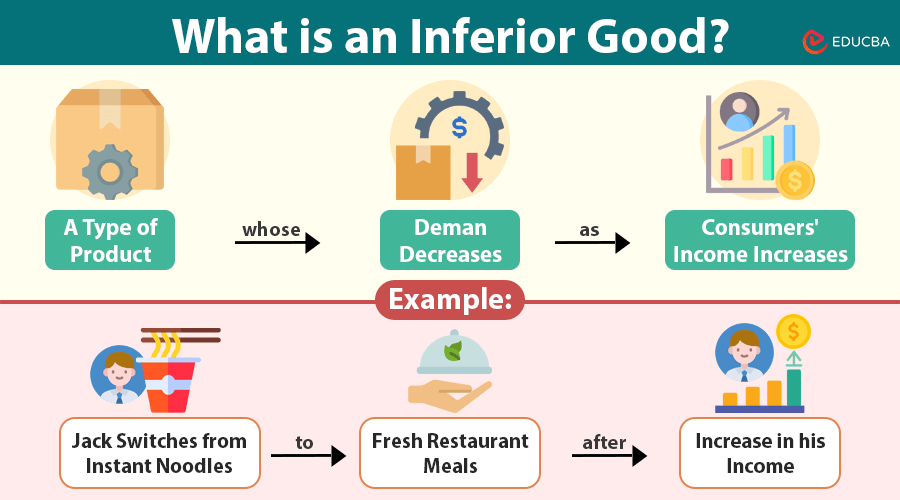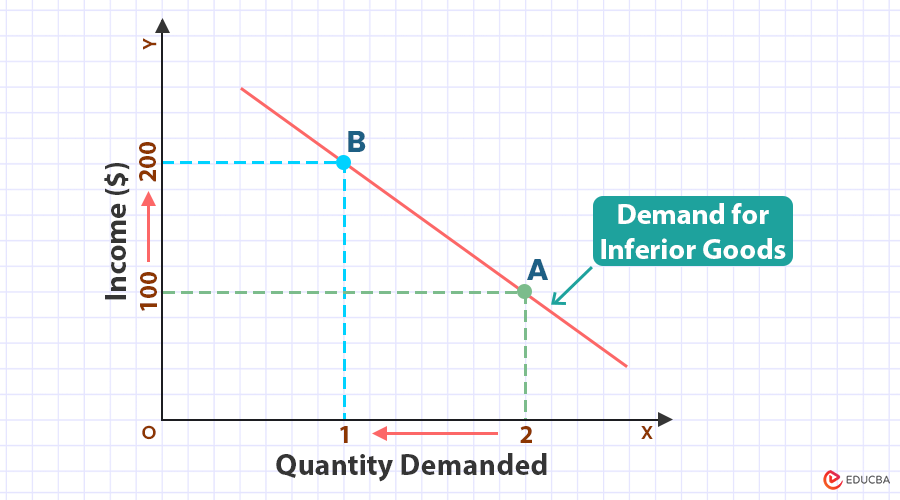
What is an Inferior Good?
An inferior good is a type of product whose demand decreases as consumers’ income increases.
In other words, when people earn more money, they tend to buy less of the inferior good and switch to higher-quality alternatives. On the other hand, when income falls, demand for inferior goods rises because they are more affordable.
A common example of an inferior good is instant noodles. A person with a low income may buy instant noodles frequently because they are cheap and easy to prepare. However, when their financial situation improves, they might opt for healthier or more expensive alternatives like fresh pasta or dining at restaurants.
Key Characteristics of Inferior Goods
- Income Elasticity of Demand is Negative: The demand for an inferior good decreases as income rises and increases when income falls.
- Availability of Superior Alternatives: Inferior goods often have better-quality substitutes that consumers prefer when they can afford them.
- Common in Budget-Conscious Consumption: These goods are more popular among lower-income groups or during economic downturns.
Inferior Goods vs. Normal Goods vs. Giffen Goods
| Feature | Inferior Goods | Normal Goods | Giffen Goods |
| Definition | Goods whose demand decreases as consumer income increases | Goods whose demand increases as consumer income increases | A special type of inferior good where demand increases despite a price rise due to lack of substitutes |
| Income Effect | Negative – higher income leads to lower demand | Positive – higher income leads to higher demand | Strong negative income effect that outweighs the substitution effect |
| Price Effect | If the price decreases, demand may increase | If the price decreases, demand increases | If the price increases, demand increases (violates the law of demand) |
| Examples | Instant noodles, public transport, low-cost clothing | Fresh food, branded clothes, private transport | Staple food like rice, bread, and potatoes in low-income groups |
| Consumer Behavior | As income rises, consumers switch to better alternatives | As income rises, consumers buy more of the good | Due to extreme poverty, consumers cannot afford alternatives and buy more even as price rises |
Examples of Inferior Goods
- Public Transportation: Many people rely on buses and trains when their income is low but switch to personal vehicles when they earn more.
- Generic or Store-Brand Products: Some consumers buy generic groceries when money is tight but opt for branded versions when their income improves.
- Second-Hand Items: Thrift stores and used products are often in high demand among those with limited financial resources.
- Fast Food: Low-cost meals from fast-food chains tend to be consumed more during financial struggles, whereas higher incomes lead to healthier food choices.
- Low-Cost Supermarket Meats: Some people buy cheaper cuts of meat when on a budget but prefer premium cuts when they can afford them.
Graphical Representation
This graphical representation helps explain why inferior goods become less desirable as consumers’ financial situations improve.
In the graph above:
- Y-axis (vertical) represents consumer income.
- X-axis (horizontal) represents the quantity demanded.
- The demand curve slopes downward, showing an inverse relationship between income and demand for inferior goods.
Key Points:
- At an income level of $100, the quantity demanded is 2.
- When income increases to $200, the quantity demanded drops to 1.
- This shows that as people earn more, they buy less of the inferior goods.
- The downward-sloping demand curve highlights this negative relationship.
Real-Life Impact of Inferior Goods
- Economic Recession and Inferior Goods: People rely more on inferior goods during economic downturns as disposable income
- Developing vs. Developed Countries: Inferior goods are more commonly consumed in developing countries with lower incomes.
- Consumer Behavior Shifts: As economic conditions change, businesses must adapt their product offerings based on whether consumers are shifting toward or away from inferior goods.
Importance of Inferior Goods in Economic Analysis
- Understanding Consumer Preferences: Helps economists analyze how spending behavior changes with income.
- Business Strategy Development: Companies can target budget-conscious consumers with affordable options.
- Government Policy Making: Policymakers consider inferior goods while designing welfare programs and economic recovery plans.
How Businesses Use Inferior Goods to Their Advantage?
- Targeting Low-Income Consumers: Companies focus on affordability and large-scale production to keep prices low.
- Marketing Strategy: Advertising highlights cost-effectiveness rather than premium quality.
- Diversifying Offerings: Many brands have both inferior and normal goods to serve different market segments.
Final Thoughts
Inferior goods are important because they serve people with lower incomes. While they may not be the preferred choice for higher-income people, they provide an essential safety net during financial struggles. Understanding the demand patterns of inferior goods can help businesses, policymakers, and economists make informed decisions. Whether it is public transportation, store-brand groceries, or second-hand items, inferior goods continue to shape consumer behavior worldwide.
By comprehending the nature of inferior goods, individuals and businesses can better navigate economic fluctuations and optimize their spending and investment strategies.
Frequently Asked Questions (FAQs)
Q1. Can a good be inferior in one country and normal in another?
Answer: Yes, classifying a good as inferior or normal depends on consumers’ income levels and preferences in a particular region. For example, a good considered inferior in a high-income country might be a normal good in a lower-income country.
Q2. Are all cheap products considered inferior goods?
Answer: No, not all low-priced goods are inferior. A product’s classification as inferior depends on how its demand changes with income, not just its price. Some cheap goods can still see increased demand as income rises, making them normal goods.
Q3. Can businesses successfully rebrand an inferior good?
Answer: Yes, businesses can rebrand or reposition inferior goods by improving quality, packaging, or marketing to appeal to a broader audience and shift consumer perception.
Q4. Can digital products be considered inferior goods?
Answer: Yes, consumers may consider digital products like basic online courses or free mobile apps as inferior goods when they switch to paid, premium alternatives as their income increases.
Recommended Articles
We hope this guide helps you understand the concept of inferior goods and their role in consumer behavior. Explore these recommended articles for deeper insights into economic concepts and smart spending habits.


